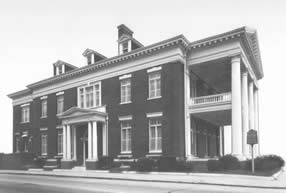Cape Fear Club
The Cape Fear Club is a business and professional men's club, founded on 3 Mar. 1866 in Wilmington and incorporated on 8 Feb. 1872. It is generally recognized as the oldest social club of its kind in continuous existence in North Carolina and one of the oldest in the Southeast. The club was largely organized by former Confederates; its 1868 membership roster listed 1 former brigadier general (William MacRae), 10 colonels, 5 majors, and 13 captains. Several of the founders had previously belonged to a gentleman's club called the Hollowleg Club, organized in Wilmington in 1852 and dissolved at the outbreak of the Civil War.
From the start, the Cape Fear Club had close ties to the railroad industry. Guilford Lafayette Dudley, its first president, was general freight agent for the Wilmington & Weldon Railroad. Champion McDowell Davis, the longtime president of the Atlantic Coast Line Railway, was president of the club from 1922 to 1926. Officially nonpartisan, the club has nevertheless exerted strong influence in Wilmington affairs. At its centennial in 1966, its members included the mayor, the city manager, two city councilmen, and executives of most of the area's largest companies. During the 1980s the club's lack of black and women members was sometimes raised as a political issue.
The club owns a number of seventeenth-century Italian paintings donated anonymously (probably by Henry Walters, a club member, chairman of the board of the Atlantic Coast Line and founder of the Walters Art Gallery in Baltimore). It also has an extensive collection of U.S. Navy, Coast Guard, and maritime memorabilia, acquired in part through its long association with the U.S. Navy League.
References:
Leslie N. Boney Jr., ed., The Cape Fear Club, 1967-1983 (1984).
Tony P. Wrenn, Wilmington, N.C.: An Architectural and Historical Portrait (1984).
Additional Resources:
Cape Fear Club, NC Historical Mark D-71: https://www.ncdcr.gov/about/history/division-historical-resources/nc-highway-historical-marker-program/Markers.aspx?ct=ddl&sp=search&k=Markers&sv=D-71%20-%20CAPE%20FEAR%20CLUB
North Carolina Department of Cultural Resources Digital Collections, Act to incorporate Cape Fear Club: Private laws of the State of North-Carolina, passed by the General Assembly [1871-1872]
Image Credit:
The Cape Fear Club. Image courtesy of the Cape Fear Historical Institute. Available from http://www.cfhi.net/ColonelFWKerchner.php (accessed August 9, 2012).
1 January 2006 | Steelman, Bennett L.
